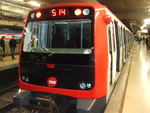Casa Trinxet

Casa Trinxet was a building designed by the Catalan Modernisme architect Josep Puig i Cadafalch (also architect of Casa Amatller) and built during the years 1902–1904, officially considered completed in 1904. It was located at the crossroads of Carrer Balmes and Carrer del Consell de Cent, in the Eixample district of Barcelona, Catalonia, Spain. Casa Trinxet was "one of the jewels of Barcelona Modernisme" and one of the buildings of Barcelona's Illa de la Discòrdia ("Block of Discord"), because of competing attitudes among Domènech i Montaner, Puig i Cadafalch and Antoni Gaudí.The building was commissioned by Avelino Trinxet Casas, Mir Trinxet's Uncle, who belonged to the textile industrial family Trinxet, from Barcelona.
Excerpt from the Wikipedia article Casa Trinxet (License: CC BY-SA 3.0, Authors, Images).Casa Trinxet
Carrer de Balmes, Barcelona
Geographical coordinates (GPS) Address Nearby Places Show on map
Geographical coordinates (GPS)
| Latitude | Longitude |
|---|---|
| N 41.394166666667 ° | E 2.1566666666667 ° |
Address
Carrer de Balmes 148, 150
08001 Barcelona
Catalonia, Spain
Open on Google Maps






